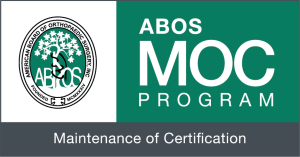Introduction
During its first 50 years, the ABOS issued certificates that were good for life. However, from the very earliest days of the American Board of Medical Specialties (ABMS), there was discussion of the need for periodic recertification, based on the idea that medical knowledge and practice change over time. The first 10 year (time-limited) certificates were issued by the ABOS in 1986.
In early 2000, the member boards of ABMS, agreed to evolve their recertification programs into a new concept called Maintenance of Certification or MOC. This path was taken in response to public and state legislative pressure to evaluate physician competence on a more frequent schedule. All ABMS Boards have adopted the MOC program.
There are approximately 31,000 ABOS Board Certified Orthopaedic Surgeons–Diplomates. Diplomates can use the designation “ABOSD” after their name. For instance, John Doe, MD, ABOSD.
Maintenance of Certification
All ABOS diplomates with time-limited certificates who wish to remain Board Certified will be allowed to do so by complying with requirements of the MOC program established by the ABOS. MOC is also available to time-unlimited (lifetime) certificate holders who wish to voluntarily participate in the MOC process, including recertification. The MOC program has four components.
- Part I: Evidence of Professional Standing, which is assessed with peer review, confirmation of full and unrestricted licensure in all jurisdictions where a license is held, and hospital credentials.
- Part II: Evidence of Life-Long Learning and Self-Assessment, which is addressed through 240 credits of Category 1 Continuing Medical Education (CME) that include a minimum of 40 CME credits of Self-Assessment Examinations (SAE) by the end of your 10-year MOC cycle. Diplomates whose ABOS Board Certification expires in 2031 or later must earn at least 120 CME credits that include a minimum of 20 CME credits of SAE, between years 1-5 of their MOC Cycle. They must earn an additional 120 CME credits that include a minimum of 20 CME credits of SAE, between years 6-10 of their MOC Cycle. Additional credits earned in years 1-5 will not be included in years 6-10.
- Part III: Evidence of Cognitive Expertise, which is the successful completion of one of three ABOS Knowledge Assessments: 1) Computer-based Examination, 2) Oral Examination, or 3) ABOS WLA
- Part IV: Evidence of Performance in Practice, focuses on quality improvement model that includes a stringent peer review process and submission of case lists. The Board will obtain peer review of the candidate from certified orthopaedic surgeons who are familiar with their work, and get evaluations from the hospital chief of staff, chief of orthopaedics, surgery, anesthesia, and nursing staff in the operating room and orthopaedic wards. The Diplomate must also submit a Professional Standing Update and Case List in years 7, 8, or 9 of their 10-year MOC Cycle. This information is reviewed by the credentials committee of the ABOS.
A Diplomate’s certification may be subject, in accordance with the ABOS Rules and Procedures, to a Credentials Committee review prior to the expiration of your ten-year period of certification where the Credentials Committee concludes that such review is necessary for an adequate evaluation of whether your practice adheres to accepted professional standards and you have satisfactorily adhered to the MOC Professional Standing requirements. The Credentials Committee may take action against your certification, up to and including termination of your certification, prior to the expiration of the ten-year term based on the results of its review.
